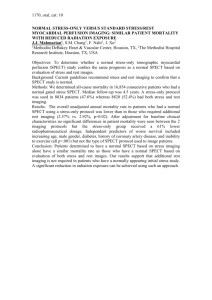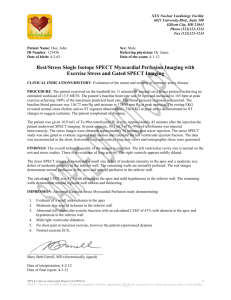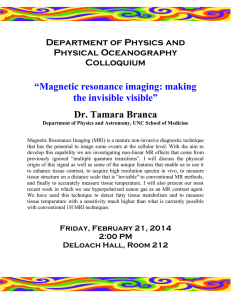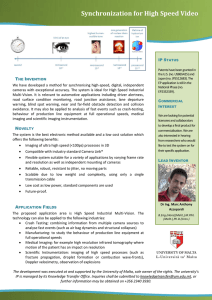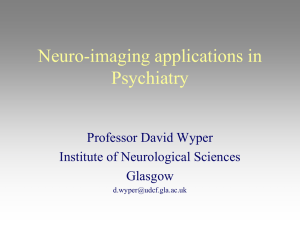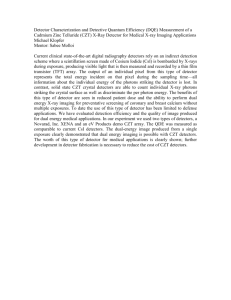Document 14224139
advertisement
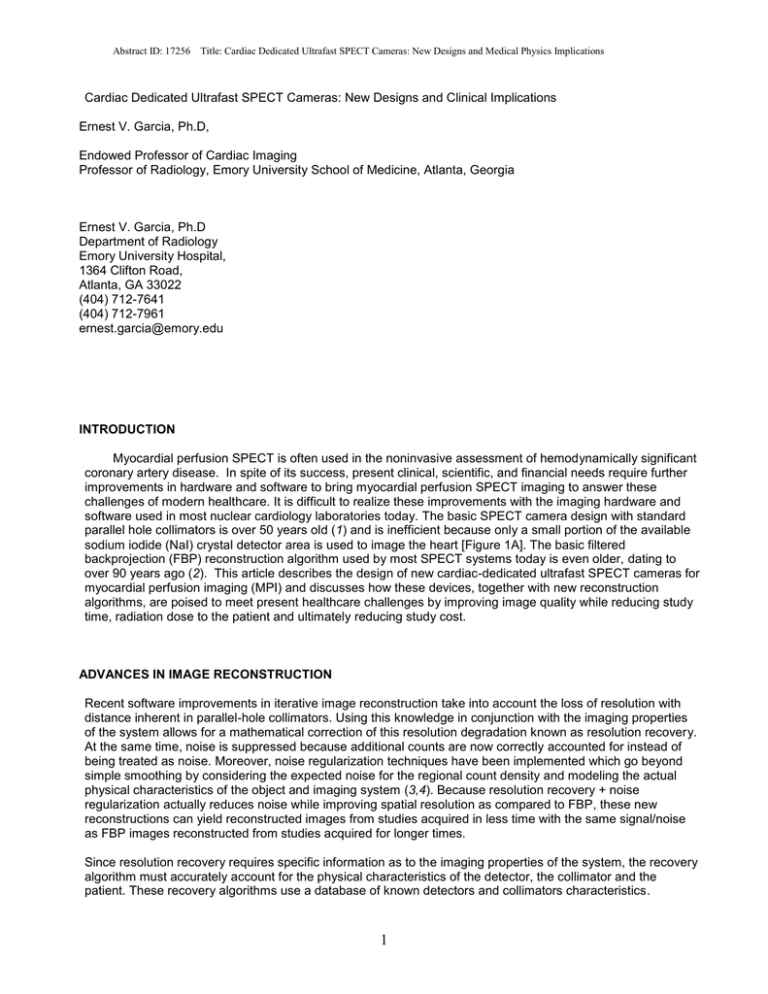
Abstract ID: 17256 Title: Cardiac Dedicated Ultrafast SPECT Cameras: New Designs and Medical Physics Implications Cardiac Dedicated Ultrafast SPECT Cameras: New Designs and Clinical Implications Ernest V. Garcia, Ph.D, Endowed Professor of Cardiac Imaging Professor of Radiology, Emory University School of Medicine, Atlanta, Georgia Ernest V. Garcia, Ph.D Department of Radiology Emory University Hospital, 1364 Clifton Road, Atlanta, GA 33022 (404) 712-7641 (404) 712-7961 ernest.garcia@emory.edu INTRODUCTION Myocardial perfusion SPECT is often used in the noninvasive assessment of hemodynamically significant coronary artery disease. In spite of its success, present clinical, scientific, and financial needs require further improvements in hardware and software to bring myocardial perfusion SPECT imaging to answer these challenges of modern healthcare. It is difficult to realize these improvements with the imaging hardware and software used in most nuclear cardiology laboratories today. The basic SPECT camera design with standard parallel hole collimators is over 50 years old (1) and is inefficient because only a small portion of the available sodium iodide (NaI) crystal detector area is used to image the heart [Figure 1A]. The basic filtered backprojection (FBP) reconstruction algorithm used by most SPECT systems today is even older, dating to over 90 years ago (2). This article describes the design of new cardiac-dedicated ultrafast SPECT cameras for myocardial perfusion imaging (MPI) and discusses how these devices, together with new reconstruction algorithms, are poised to meet present healthcare challenges by improving image quality while reducing study time, radiation dose to the patient and ultimately reducing study cost. ADVANCES IN IMAGE RECONSTRUCTION Recent software improvements in iterative image reconstruction take into account the loss of resolution with distance inherent in parallel-hole collimators. Using this knowledge in conjunction with the imaging properties of the system allows for a mathematical correction of this resolution degradation known as resolution recovery. At the same time, noise is suppressed because additional counts are now correctly accounted for instead of being treated as noise. Moreover, noise regularization techniques have been implemented which go beyond simple smoothing by considering the expected noise for the regional count density and modeling the actual physical characteristics of the object and imaging system (3,4). Because resolution recovery + noise regularization actually reduces noise while improving spatial resolution as compared to FBP, these new reconstructions can yield reconstructed images from studies acquired in less time with the same signal/noise as FBP images reconstructed from studies acquired for longer times. Since resolution recovery requires specific information as to the imaging properties of the system, the recovery algorithm must accurately account for the physical characteristics of the detector, the collimator and the patient. These recovery algorithms use a database of known detectors and collimators characteristics. 1 Abstract ID: 17256 Title: Cardiac Dedicated Ultrafast SPECT Cameras: New Designs and Medical Physics Implications Recovery also requires specific description of the orbit shape, radius and/or distance from the patient to the detector. Most SPECT camera manufacturers have implemented some version of resolution recovery/ noise regularization (RRNR) algorithms into their maximum likelihood expectation maximization (MLEM) or ordered subset EM (OSEM) iterative reconstruction software keeping their exact details proprietary. The algorithms which were developed for conventional SPECT cameras include Astonish™ (5) (Philips Medical Systems, Milpitas CA), Flash3D™ (6) (Siemens Medical Solutions, Hoffman States, Chicago, IL), Evolution™ [3](GE Healthcare, Waukesha, Wis), nSPEED™ (7) (Digirad Corporation, Poway CA) and Wide Beam Reconstruction (3,4,8) (WBR™) by a third party vendor (UltraSPECT, Haifa, Israel). Each of these RRNR algorithms has been clinically validated to various degrees. These clinical trials compared conventional SPECT reconstruction to RRNR reconstruction of MPI studies and showed that RRNR reconstructed studies: 1) may be acquired in half the time without compromising qualitative or quantitative diagnostic performance (3-5), with or without attenuation correction (5); 2) may even be acquired in quartertime if the reconstruction is optimized for the reduced count density (8); 3) may be acquired in half the time while improving functional diagnostic performance (4); 4) provide LV volumes that correlate but are significantly smaller (4); 5) provide LVEF that correlates but are lower than conventional reconstruction due to a reduction in end diastolic volume (4) or for some implementation, increases in end systolic volume (4); and 6) provide similar diagnostic quality whether imaging time is reduced by half or a half-dose is injected (4). Importantly, variations of these RRNR algorithms have been implemented in the new ultrafast camera designs to further improve image spatial and contrast resolution while reducing count noise. NEW ULTRA FAST CAMERA DESIGNS Several manufacturers have begun to break away from the conventional SPECT imaging approach to create innovative designs of dedicated cardiac cameras. These cameras' designs have in common that all available detectors are constrained to imaging just the cardiac field of view. Figure 1B shows how 8 detectors surrounding the patient are all simultaneously imaging the heart. These new designs vary in the number and type of scanning or stationary detectors, and whether NaI, CSI or CZT solid-state detectors are used. They all have in common the potential for a 5 to 10 fold increase in count sensitivity at no loss or even a gain in resolution, resulting in the potential for acquiring a stress myocardial perfusion scan in 2 minutes or less if injected with a standard dose. Some of this gain in sensitivity can be traded for a linear reduction in the injected dose to reduce the patient's exposure to radiation. Thus in an ultrafast camera with a 10 fold increase in sensitivity using conventional radiopharmaceutical doses, the dose could be reduced by half and still maintain a 5 fold increase in sensitivity. CZT Solid-State, Multiple Scanning Detector Design (D-SPECT) The first SPECT system to offer a totally different design was D-SPECT, manufactured by Spectrum Dynamics (Caesarea, Israel) (9-12). This system uses solid-state detectors in the form of cadmium-zinc-telluride (CZT) mounted on 9 vertical columns and placed using 90° geometry. Each of the 9 detector assemblies is equipped with a tungsten, square, parallel-hole collimator. Each collimator square hole is 2.46 mm on its side, large in comparison to conventional collimators which contributes to the increased count sensitivity of the camera. Each detector assembly is made to fan in synchrony with the other 8 detector assemblies while all 9 are simultaneously imaging the heart. The patient is imaged sitting in a reclining position, similar to a dentist’s chair, with the patient’s left arm placed on top of the detector housing. Data acquisition is performed by first obtaining a 1-min scout scan for the 9 detectors to identify the location of the heart and set the limits of the detectors' fanning motion. The diagnostic scan is then performed with each detector assembly fanning within the limits determined by the scout scan. Reconstruction is performed using a modified iterative algorithm which compensates for the loss of spatial resolution that results from using large square holes in the collimator by mathematically modeling the acquisition and collimator geometry. D-SPECT Validation 2 Abstract ID: 17256 Title: Cardiac Dedicated Ultrafast SPECT Cameras: New Designs and Medical Physics Implications Initially, in a single-center clinical trial publication, it was concluded that using a stress/rest Tc-99m MPI protocol and 4 and 2 min D-SPECT acquisitions, respectively, yielded studies that highly correlated with 16 and 12 min stress/rest conventional SPECT with equivalent level of diagnostic performance (9). In a subsequent multicenter trial using D-SPECT, it was shown that using device-specific normal database quantitative analysis and a comparison protocol similar to the previous report correlated well to quantitative analysis of conventional SPECT MPI (10). Another study showed the feasibility of performing a fast sequential dual-isotope stress Tl-201/rest Tc-99m protocol with D-SPECT which could be accomplished in 20 minutes with similar image quality and dose as conventional rest/stress Tc-99m studies (11). Another small singlecenter trial showed that the higher energy resolution of the CZT detectors could be used with the D-SPECT device to perform simultaneous Tl-201 (rest)/ Tc-99m sestamibi (stress) 15 min acquisitions which compared favorably in both diagnostic accuracy and image quality to sequential acquisitions with conventional SPECT (12). D-SPECT : Measuring Imaging Performance and Calibrations Physicists show be aware that the processes for measuring imaging performance using in acceptance testing and daily quality control are highly specialized for each of these cardiac dedicated systems discussed here. Requirements from the manufacturers on how to performed these measurements should be adhered. Attempt to measure imaging performance as is done with conventional Anger-type expect cameras will result in erroneous results. Acceptance testing. After the system is properly calibrated the following measurements may be performed: a) uniformity, b) SPECT resolution, and C) SPECT contrast. Uniformity is determined using a cylindrical phantom filled with Tc-99m and imaged for 25M counts. The expected uniformity of a 2 cm thick slice should be less than 4%. For NEMA Tc-99m SPECT system resolution a cylindrical phantom loaded with 3 rod sources in a scatter medium is imaged and reconstructed under a strict resolution protocol. SPECT resolution on the average is 4.2 mm in x direction and 3.6 in y. For contrast resolution an anthropomorphic cardiac phantom is filled with .4 mCi with liver activity 3 mCi and background activity loaded with 2 mCi. Average SPECT contrast for a 2 cm cold defect is 75%. Other expected system characteristics are: a) Energy resolution between 5 to 7%, planar sensitivity using a 20% PHA window of 884 cpm/μCi and a linear system count rate till 144 kcts/s, All these specs are significantly superior to conventional SPECT detectors. Daily quality control and mechanical calibration. Mechanical calibration requires definition of the zero angle for each of the 9 heads. This along with the daily QC procedures are done with a Co-57 rod a mechanical jig and a 2 min scan. These procedures should also be performed prior to acceptance testing. Daily QC measurements includes detector registration, energy resolution, energy peaking, scan sensitivity and regional/global homogeneities. Software applications automatically test the acquisition for pass or fail status. Some of these tests are in common with the next system and will be explained there. CZT Solid-State Multiple-pinhole Detector Design (Discovery NM 530c) The second SPECT system to offer a revolutionary new design is the system developed by GE Healthcare (Waukesha, Wis) (13-20) known as the Discovery Nuclear Medicine 530c system. The SPECT design uses Alcyone™ technology, consisting of an array of 19 pinhole collimators, each with four solid-state CZT pixilated detectors, with all 19 pinholes simultaneously imaging the heart with no moving parts during data acquisition. Nine of the pinhole detectors are oriented perpendicular to the patient's long axis while 5 are angulated above and 5 below the axis for a true 3D acquisition geometry. The use of simultaneously acquired views improves the overall sensitivity and gives complete and consistent angular data needed for both dynamic studies and for the reduction of motion artifacts. In addition, attenuation artifacts may be reduced because not all views are through the attenuator—some may view the heart from above or below. The detector assembly is mounted on a gantry which allows for patient positioning in the supine or prone positions. A hybrid system (570c) is also available with a volumetric CT scanner to facilitate attenuation correction as well as CT applications. Iterative 3 Abstract ID: 17256 Title: Cardiac Dedicated Ultrafast SPECT Cameras: New Designs and Medical Physics Implications reconstruction adapted to this geometry is used to create transaxial slices of the heart and to perform attenuation correction. The use of CZT detectors improves the energy, spatial and contrast resolution of these imaging systems through the use of direct conversion of the energy and location of the detected photon into an electronic pulse in contrast of the indirect conversion used in conventional NaI(Tl) detector cameras. In NaI cameras the energy of the gamma ray is first absorbed by the crystal converting it to a large number of visible photons which have to leave the crystal to be detected by all photomultiplier tubes (PMTs) which then covert it to individual electronic pulses. The sum of the pulses from all PMTs is used as an energy signal and the weighted sum as the position of the event in the crystal. Any loss of visible photons contributes to miscalculating the energy and location of the event. In the CZT direct conversion scheme, the gamma ray is ideally absorbed by one of the 2.46 mm pixels and directly converted to an electrical pulse providing both the energy and location of the event (Figure 2). Interestingly, both this Alcyone system and the D-SPECT system use the same CZT detectors from the same manufacturer with the Discovery system using 76 (19 x 4) detectors while D-SPECT uses 36 (9 x 4). Compared to a state-of-the-art conventional SPECT system the Alcyone™ system has been shown to have 1.65 times better energy resolution (5.7% vs. 9.4%), approximately twice better spatial resolution (5mm vs. 11 mm central) and 5 (cardiac phantom) to 10 (point source) times more count sensitivity (13). Discovery NM 530c Validation In the first multicenter trial it was demonstrated that using a conventional 1-day Tc-99m tetrofosmin rest/stress MPI protocol and 4 and 2 min Alcyone™ acquisitions, respectively, yielded studies that diagnostically agreed 90% of the time with 14 and 12 min rest/stress conventional SPECT acquisitions (14). Importantly, this trial also showed excellent LVEF correlations between the 530c and conventional SPECT for rest (r = .93, p < .001) and stress (r = .91, p < .001) gated MPI studies (14). A subsequent single-center trial was performed using a 1-day Tc-99m tetrofosmin adenosine-stress/ rest MPI protocol and a 3 min scan for stress and 2 min for rest using the 530c camera compared to 15-min conventional SPECT acquisitions for stress and rest (15). These investigators concluded that the 530c camera allows a more than 5-fold reduction in scan time and provides clinical perfusion and function information equivalent to conventional dual-head SPECT MPI. In other reports, these same investigators suggested that for the 530c camera: 1) using conventional 1-day low dose/high dose protocols optimal imaging times are 3 min and 2 min respectively (16), 2) breath triggering was facilitated assisting in the discrimination of artifacts from true hypoperfusion similar to attenuation correction (17), 3) allowed for assessment of LV dyssynchrony with a scan time of 5 min (18), 4) allowed for attenuation correction (AC) using a CT transmission scan yielding excellent clinical agreement when compared to conventional SPECT with AC (19) and 5) allowed for image fusion with CT angiography (20). Discovery NM-530c: Measuring Imaging Performance and Calibrations Acceptance testing and QC procedures. The procedures for this system are different from the previous system mostly in that it uses a Co-57 square flood source (rather than a rod) for performing most of the tests. The flood source is mounted on a holder at 3 different positions to have all 19 detectors tested. Automatic software applications test for a pass/fail system and detector status for the following parameters: PHA peak, Energy resolution, detector uniformity, number of faulty pixels and provides for visual inspection images of the energy spectrum and uniformity. Acceptance testing includes passing the daily QC tests. Daily QC also checks the high voltage and low voltage power supplies. Acceptance limits per detector for the Co-57 (122 keV) phantom are: Peak position= 120.5-123.5 keV, Energy FWHM = up to 7%, uniformity 7%. System performance are acquired with cylindrical phantoms in a manner quite similar to that explained above for D-SPECT. Common QC for CZT detectors. During the QC procedures two tests for detector performance are performed. The first one the noisy pixel test. This test is done by performing an acquisition at the home position with no activity in the field of view. CZT detect pixels commonly generate electric noise below a threshold. Beyond proper function, this noise is also temperature and humidity dependent. A proper environment is required for proper operation. The second test is the bad/faulty pixel test. This one is performed with the Co-57 phantom in the field of view and is energy/sensitivity dependent. These may be 4 Abstract ID: 17256 Title: Cardiac Dedicated Ultrafast SPECT Cameras: New Designs and Medical Physics Implications improved with recalibrating the energy maps in the system. When the system cannot bring these bad pixels to proper operation it replaces their count values in the detector image by the weighted average of the surrounding pixels. The software application passes or fails the QC depending on how many pixels are faulty on a particular detector, location and cluster of the pixels. ROTATING CAMERA DEVELOPMENTS In addition to the radically new camera designs described above, other manufacturers and investigators have modified the electronics, system geometry or collimation in order to significantly improve the imaging performance of rotating SPECT cameras. CSI(Tl) Crystal/ diodesSolid-State Multiple Cameras Design (Cardius-3) One of the first systems developed to take advantage of solid-state electronics and use more than two detectors simultaneously imaging the heart is the Cardius 3 XPO manufactured by Digirad (Poway, California). This commercial system uses 768 pixilated, thallium activated cesium iodide [CsI(Tl)] crystals coupled to individual silicon photodiodes and digital Anger electronics to create the planar projection images used for reconstruction (7). In this system 3 detectors are fixed using a 67.5º angular separation while the patient is rotated through an arc of 202.5 º sitting on a chair with his arms resting above the detectors. Typical acquisition times for a study are 7.5 min. Manufacturers of this device claim up to 38% more count sensitivity compared to conventional dual-head systems, while maintaining comparable image quality. For attenuation correction the system uses a mono-energetic fluorescent X-ray source to create transmission photons which are detected by the same 3 camera detectors positioned next to each other (22). It is then called the X-ACT. Cardius-3 Validation In a large multicenter trial using nSPEED and Digirad cameras a subset of 189 patients were acquired using the Cardius triple head system and conventional doses and compared to conventional SPECT. Using this combination the study showed that a 5 min rest acquisition and 4 min stress acquisition yielded perfusion and function information from gated SPECT MPI studies which were diagnostically equivalent to full-time acquisition and 2D-OSEM reconstructions (7). Cardius 3 (X-ACT) : Measuring Imaging Performance and Calibrations Since this solid-state camera operates more like a conventional rotating SPECT camera that the other two solid-state cameras discussed is follows similar acceptance and daily QC procedures to what is standard. These include measurements for energy resolution, planar sensitivity, maximum linear count rate and all the resolution and uniformity phantom measurements which are standard. Daily QC includes a flood uniformity test and a blank scan for attenuation correction as well as a weekly center of rotation test and a co-registration test to align the emission and transmission images for attenuation correction. The emission/transmission co-registration test requires 3 Tc-99m sources loaded in 3 cc syringes with equal activity in a volume of at least 1 cc. Each syringe is placed in a co-registration lead phantom with a source gap and emission and transmission data are acquired. This system design yields energy resolution < 7.9% at 140keV. Each individual pixel is independent of the other pixels so maximum detector count rates can be very high also facilitating that the same detectors are used for emission and x-ray transmission images. The modular design allows the field of view to be as large as desired by tilling multi-side, buttable modules, albeit by increasing acquisition time. Camera can continue to be used for imaging with dead pixels or modules as long as they do not obscure a desired area of the image 5 Abstract ID: 17256 Title: Cardiac Dedicated Ultrafast SPECT Cameras: New Designs and Medical Physics Implications FAST-SPEED MPI: CLINICAL IMPLICATIONS The camera design and software improvements reviewed in this article result in a reduction of acquisition time for an MPI study anywhere from half of the conventional acquisition time down to a minimum 2-min acquisition. Clinically, these fast acquisitions would allow flexibility of acquisition protocols to reduce camera/patient total time to reduce cost and increase patient comfort. Reduced acquisition times would also lead to decreased patient motion which results from translation, smearing and breathing. Moreover, some of the count sensitivity increase may be traded for respiratory gating to eliminate the image smearing caused by the chest motion and help reduce the artifacts caused by the overlap of a hot liver and the LV inferior wall. High count efficiency would also allow true stress acquisitions of myocardial function, as well as dynamic acquisition of SPECT tracers, similar to what is done with PET tracers. Dynamic imaging opens the door to the quantification of blood flow and coronary flow reserve, which can be used to detect disease earlier and to avoid interpretation of 3-vessel disease patients as normal (24). These technical breakthroughs in image reconstruction and truly cardiac dedicated SPECT camera design have made high-speed myocardial perfusion imaging a reality (25). Reduced Dose vs. Increased Efficiency It is clear that these more efficient hardware/software imaging systems also allow for high quality images obtained using a lower injected radiopharmaceutical dose and thus a decrease in the radiation dose absorbed by the patient and staff. This reduction in dose comes at an increase in acquisition time, even if the total time is less than what has been traditionally used in conventional systems. Since currently there are no financial incentives for using a lower radiopharmaceutical dose a laboratory interested in just reducing costs would tend to opt for the most efficient protocol possible. Recently, the American Society of Nuclear Cardiology published an information statement (26) recommending that laboratories use imaging protocols that achieve on average a radiation exposure of ≤ 9 mSv in 50% of the studies by 2014. Although there are many different protocols that may be implemented to accomplish this exposure goal, use of the more efficient hardware/software described herein would greatly facilitate this goal and allow for increases in efficiency over the imaging protocols used today. Protocol Flexibility vs. Standardized Imaging The widespread acceptance and success of MPI is owed in large part to the efforts of the American Society of Nuclear Cardiology (27) and the Society of Nuclear Medicine [28] to standardize the entire imaging procedure. These standards provide very specific details for the many parameters included in MPI protocols and promote consistent high quality images. These parameters include: stress method, rest and stress dose injected, acquisition times, delay between injections, collimator type, reconstruction type, filters, and many others. These guidelines (27,28) have been developed mostly for rotating dual-head SPECT systems. As new ultrafast cardiac-centric designs are commercialized, each with their own proprietary reconstruction implemented, the more challenging it will be to continue to standardize protocols. Moreover, as these new designs allow for flexible imaging with a plethora of potential protocols (which may be patient-specific) the more challenging our ability to implement standardization. Thus protocols may vary from a 30 mCi stress-only MPI study with a CZT device with a 2-min acquisition, to the more conventional 14 min rest/ 12 min stress MPI studies with 2- to 4hour delay between rest and stress injections, to simultaneous dual isotope studies, to studies performed with 5 mCi or less. The long-term success of nuclear MPI will depend on our ability to quickly converge on a discrete set of protocols that can be standardized for the entire field. Summary Dedicated cardiac SPECT cameras are undergoing a profound change in design for the first time in 50 years. The scintillation camera general purpose design is being replaced with systems with multiple detectors focused on the heart yielding 5 to10 times the sensitivity of conventional SPECT. Some of the designs also replace the NaI(Tl) crystal with solid-state electronic detectors with superior energy resolution. There are also significant innovations in reconstruction software incorporated into these newly designed systems that take into account the true physics of the SPECT reconstruction geometry to gain at least a factor of 2 in sensitivity. These innovations are resulting in shorter study time and/or reduced radiation dose to the patient. Shorter study times 6 Abstract ID: 17256 Title: Cardiac Dedicated Ultrafast SPECT Cameras: New Designs and Medical Physics Implications promote easier scheduling, higher patient satisfaction and importantly less patient motion during acquisition which translates to higher quality images. Some of these new systems are also ideally suited for dynamic applications facilitating measurements of coronary flow reserve. The fast acquisition also makes the hybrid SPECT/CT systems more practical since it allows the CT scanner to be used for a longer part of the day. Physicists show be aware that the processes for measuring imaging performance using in acceptance testing and daily quality control are highly specialized for each of these cardiac dedicated systems. Requirements from the manufacturers on how to performed these measurements should be adhered. Attempt to measure imaging performance as is done with conventional Anger-type expect cameras will result in erroneous results. ACKNOWLEDGMENT The following individuals are acknowledged for their valuble contribution to this syllabus: Dr. Tracy Faber, Dr. Fabio Esteves, Dr. Aaron Peretz, Mr. Reuven Brenner, Dr. Richard Conwell and Mr. Josh Gurewitz. Dr. Ernest Garcia was an investigator in a research grant funded by GE Healthcare to evaluate GE’s Discovery NM 530c described in this article. 7 Abstract ID: 17256 Title: Cardiac Dedicated Ultrafast SPECT Cameras: New Designs and Medical Physics Implications REFERENCES 1. 2. 3. 4. 5. 6. 7. 8. 9. 10. 11. 12. 13. 14. 15. 16. 17. 18. 19. 20. Anger HO. “Scintillation Camera”, The Review of Scientific Instruments. 1958;29:27-33. J. Radon, "Uber due bestimmung von funktionen durch ihre intergralwerte langsgewisser mannigfaltigkeiten (on the determination of functions from their integrals along certain manifolds," Berichte Saechsische Akademie der Wissenschaften. 1917; 29:262 - 277. Borges-Neto S, Pagnanelli RA, Shaw LK, et al. Clinical results of a novel wide beam reconstruction method for shortening scan time of Tc-99m cardiac SPECT perfusion studies. J Nucl Cardiol. 2007;14:555-65. DePuey EG, Gadraju R, Clark J, Thompson L, Anstett F, Shwartz SC. Ordered subset expectation maximization and wide beam reconstruction “half-time” gated myocardial perfusion SPECT functional imaging: A comparison to “full-time” filtered backprojection. J Nucl Cardiol. 2008;15:547-63. Venero, CV, Heller GV, Bateman TM, et al. A multicenter evaluation of a new post-processing method with depth-dependent collimator resolution applied to full and half-time acquisitions with and without AC. J Nucl Cardiol 2009;16:714-725 Vija AH, Hawman EG, Engdahl JC. Analysis of a SPECT OSEM reconstruction method with 3D beam modeling and optional attenuation correction: phantom studies. Nuclear Science Symposium Conference Record. 2003;4:2662-2666 Maddahi J, Mendez R, Mahmarian J, et al. Prospective multi-center evaluation of rapid gated SPECT myocardial perfusion upright imaging. J Nucl Cardiol. 2009;16:351-7. DePuey EG, Bommireddipally S, Clark J, Thompson L, Srour Y. Wide beam reconstruction “quarter-time” gated myocardial perfusion SPECT functional imaging: a comparison to “full-time” ordered subset expectation maximization. J Nucl Cardiol. 2009;16:736-752. Sharir T, Ben-Haim S, Merzon K, et al. DS. High-Speed Myocardial Perfusion Imaging: Initial Clinical Comparison With Conventional Dual Detector Anger Camera Imaging. J Am Coll Cardiol Img. 2008;1:156-163. Sharir T, Slomka PJ, Hayes SW et al. Multicenter trial of high-speed versus conventional single-photon emission computed tomography imaging: quantitative results of myocardial perfusion and left ventricular function. J Am Coll Cardiol. 2010:55:1965-74. Berman DS, Kang X, Tamarappoo B, Wolak A, et al. Stress thallium-201/rest technetium-99m sequential dual isotope high-speed myocardial perfusion imaging. JACC Cardiovascular Imaging. 2009;2:273-82. Ben-Haim S, Hutton BF, Van Grantberg D. Simultaneous dual-radionuclide myocardial perfusion imaging with a solid-state dedicated cardiac camera. Eur J Nucl Med Mol Imaging. 2010;37:1710-21. Garcia EV, Tsukerman L, Keidar Z. A new solid state ultra fast cardiac multi-detector SPECT System. J Nucl Cardiol. 2008;15:S3. (abstract) Esteves FP, Raggi P, Folks RD, et al. Novel solid-state-detector dedicated cardiac camera for fast myocardial perfusion imaging: multicenter comparison with standard dual detector cameras. J Nucl Cardiol. 2009;16:927-24. Buechel RR, Herzog BA, Husmann L, et al. Ultrafast nuclear myocardial perfusion imaging on a new gamma camera with semiconductor detector technique: first clinical validation. Eur J Nucl Med Mol Imaging. 2010;37:773-778. Herzog BA, Buechel RR, Katz R, et al. Nuclear Myocardial Perfusion Imaging with a Cadmium-ZincTelluride Detector Technique: Optimized Protocol for Scan Time reduction. J Nucl Med. 2010;51:46-51. Buechel RR, Pazhenkottil AP, Herzog BA, et al.Real-time breath-hold trigerring of myocardial perfusion imaging with a novel cadmium-zinc-telluride Detector gamma camera. Eur J Nucl Med Mol Imaging. 2010;37:773-778. Pazhenkottil AP, Buechel RR, Herzog BA, et al. Ultrafast assessment of left ventricular dyssynchrony from nuclear myocardial perfusion imaging on a new high-speed gamma camera. Eur J Nucl Med Mol Imaging. 2010;37:2086-2092. Herzog BA, Buechel RR, Husmann L, et al. Validation of CT Attenuation Correction for High-Speed Myocardial Perfusion Imaging Using a Novel Cadmium-Zinc-Telluride Detector Technique. J Nucl Med. 2010;51:1539-1544. Pazhenkottil AP, Husmann L, Kaufmann PA: Cardiac hybrid imaging with high-speed single-photon emission computed tomography/CT camera to detect ischaemia and coronary artery obstruction. Heart 2010; Published online, doi: 10.1136/hrt.2010.201996. 8 Abstract ID: 17256 Title: Cardiac Dedicated Ultrafast SPECT Cameras: New Designs and Medical Physics Implications 21. 22. 23. 24. 25. 26. 27. 28. Garcia EV, Faber TL. New Trends in Camera and Software Technology in Nuclear Cardiology. Cardiol Clin. 2009;27:227-236. Bai C, Conwell R, Kindem J, et al. Phantom evaluation of a cardiac SPECT/VCT system that uses a common set of solid-state detectors for both emission and transmission scans. J Nucl Cardiol. 2010;17:459-69. Corbett J, Meden J, Ficaro E. Clinical validation of attenuation corrected cardiac imaging with IQ-SPECT SPECT/CT. J Nucl Med. 2010;51(Supplement 2):1722 (abstract). Breault C, Roth N, Slomka PJ, et al. Quantification of Myocardial Perfusion Reserve Using Dynamic SPECT Imaging in Humans. J Nucl Cardiol. 2010 4;733 (abstract). Bonow RO. High-Speed Myocardial Perfusion Imaging: Dawn of a New Era in Nuclear Cardiology? J. Am. Coll. Cardiol. Img. 2008;1:164 - 166. Cerqueira MD, Allman KC, Ficaro EP, et al. Recommendations for reducing radiation exposure in myocardial perfusion imaging. J Nucl Cardiol. 2010;17:709-18. Holly TA, Abbott BG, Al-Mallah M, et al. ASNC guidelines for nuclear cardiology procedures: Single photon-emission computed tomography. J Nucl Cardiol. doi:10.1007/s12350-010-9246-y , Published Online. Strauss HW, Miller DD, Wittry MD, Cerqueira MD, Garcia EV, Iskandrian AS, Schelbert HR, Wackers FJ, Balon HR, Lang O, Machac J. Procedure guideline for myocardial perfusion imaging 3.3. J Nucl Med Technol. 2008;36:155-61. FIGURES 9 Abstract ID: 17256 Title: Cardiac Dedicated Ultrafast SPECT Cameras: New Designs and Medical Physics Implications Figure 1. A. Limitations of Conventional SPECT Imaging. The conventional camera design used in dual detector SPECT systems is over 50 years old and limited when using standard parallel hole collimators to imaging the heart using only a small portion of the available NaI(Tl) crystal useful detector area. B. Design of new generation dedicated cardiac ultra fast acquisition scanners. This diagram shows how 8 detectors surrounding the patient are all simultaneously imaging the heart. These new designs vary in the number and type of scanning or stationary detectors, and whether a NaI or CZT solid state detectors are used. They all have in common the potential for a 5 to 10 fold increase in count sensitivity at no loss or even a gain in resolution. 10 Abstract ID: 17256 Title: Cardiac Dedicated Ultrafast SPECT Cameras: New Designs and Medical Physics Implications Figure 2. Indirect vs. direct radiation conversion. A. Indirect conversion. Panel illustrates how a conventional SPECT detector works where the NaI(Tl) crystal absorbs the gamma rays from the patient, converts its energy to visible photons which are then converted to electrical pulses by the entire array of photomultipliers (PMT). The sum of all pulses being the energy information and the distribution of pulses the location of the event in the crystal. The large number of steps to reach these final data results in opportunity for the information to be degraded at it is transferred from one mechanism to another thus reducing both the energy and spatial resolution of the system. B. Direct conversion. This panel illustrates how a CZT detector works where the detector absorbs the gamma ray from the patient directly converting its energy to charge carriers which form an electrical pulse with the information of the energy of the event and with the location being given by the location of the pixel within the CZT detector where the event took place. This more direct transfer of energy and location information results in superior energy and spatial resolution over conventional SPECT cameras. (Illustration modified from slides courtesy of Aharon Peretz, PhD). 11
